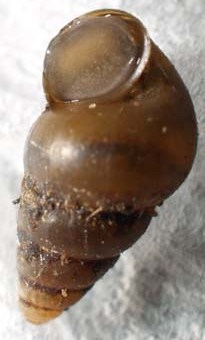Habitat
Scientists have
had trouble agreeing on the habitat of Pomatiopsis lapidaria.
Pilsbry, Shimek, and Stinson all claimed that the Slender
Walker is terrestrial (DeWitt, 1952), while Baker (1931) argues
that the snail is more amphibious in nature.
He supported his argument with the observation that the
snail will stay submerged during floods, rather than move to the
higher ground (Baker, 1931).
Ameel (1938) supports Baker’s claim by asserting that
many cercariae that require an aquatic host infect the Slender
Walker. 
Regardless of the exact
classification, it seems that scientists can agree that Pomatiopsis lapidaria
lives close to, if not in, freshwater.
Dundee (1957) claims that there are three common features to all Slender
Walker habitats: “(1) a very moist substratum with enough sand to prevent it
from becoming muck, (2) shade, and (3) fresh water”.
Dundee (1957) also points out the snail’s ability to stay in these
regions throughout the seasons. The
snail seems to get enough oxygen circulating through its gills to remain
submerged during certain spring floods (Abbott, 1948)(Baker, 1931).
Dewitt (1952) observes that it makes no attempt to find its way to drier
land. During hot summer days, it
seeks the shelter of moist aquatic vegetation or damp leaves (Baker, 1931).
Observation in the laboratory showed it is able to survive long periods
without water to help survive the sweltering summer days (Ameel, 1938).
During the winter, the Slender Walker searches for depressions in the
ground or other crevices to hibernate until warm weather returns (DeWitt, 1952).
They are able to close their opercula, or covering to their shell, to
help protect themselves from harsh conditions (DeWitt, 1952).
Pomatiopsis lapidaria is only
found in North America (Abbott, 1948).
It has not been able to establish itself west of the Rocky Mountains
(Abbott, 1948). It is found as far
north as Ontario and as far south as Florida in the Southern United States
(Abbott, 1948).